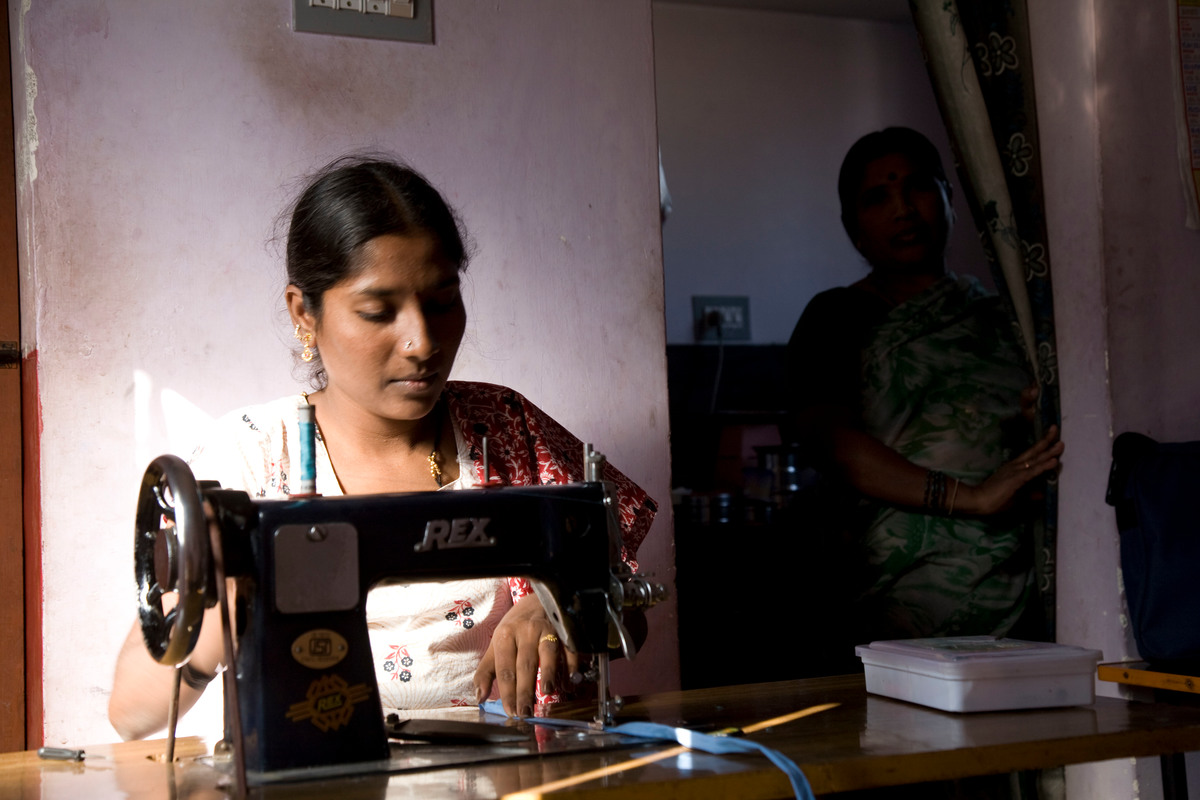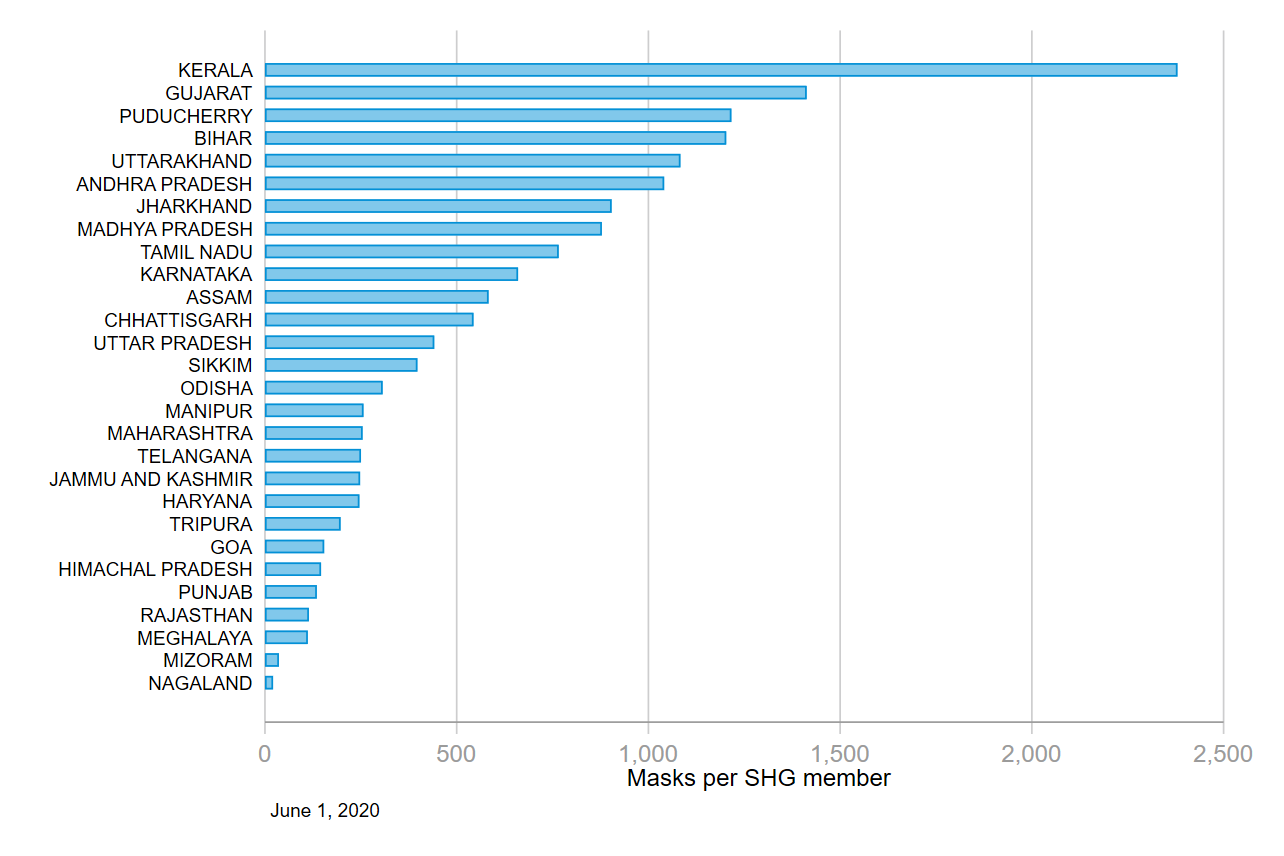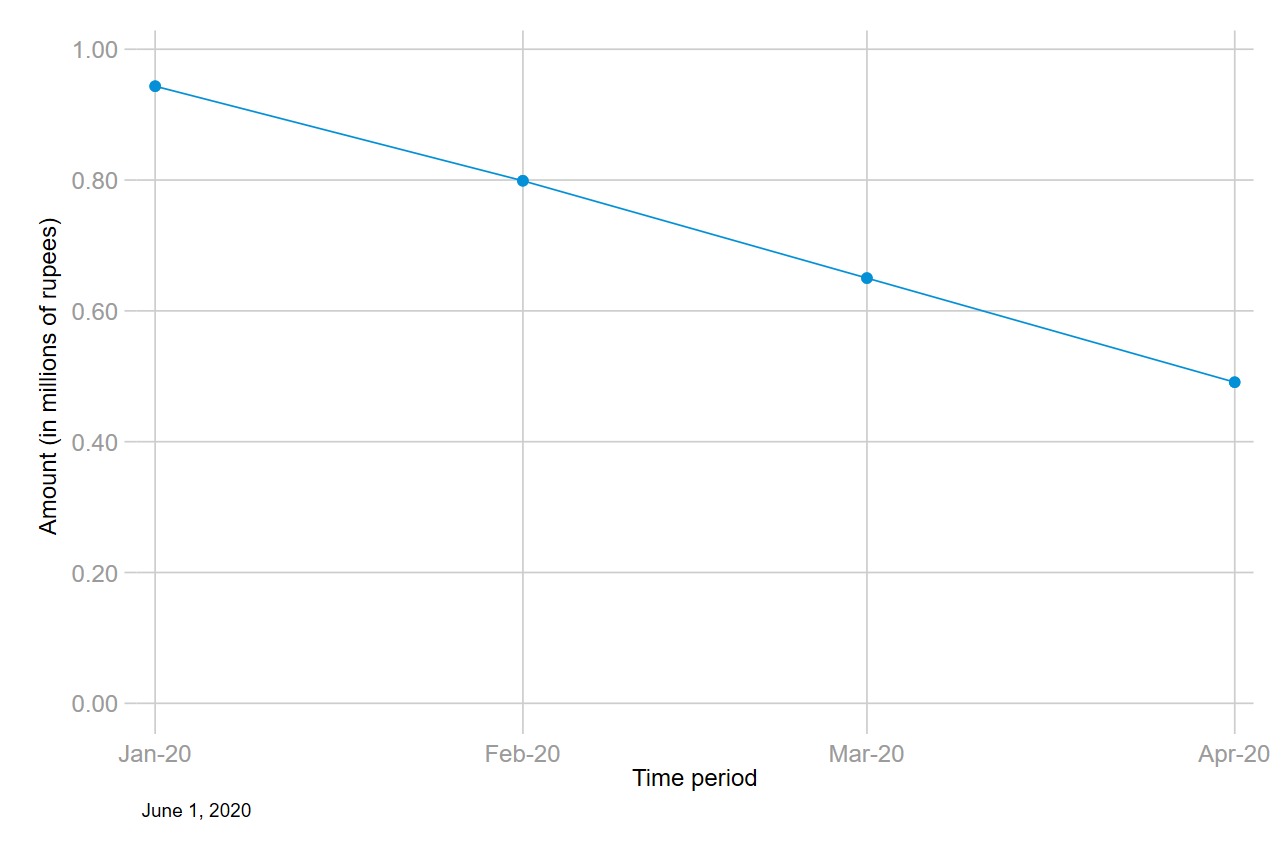
©Bill & Melinda Gates Foundation/Prashant Panjiar
Background. In the face of a worldwide pandemic and a nationwide lockdown, self-help groups (SHGs) of the National Rural Livelihoods Mission (NRLM) have emerged as an important component of the community response to the crisis in some states. As one of the world’s largest poverty alleviation programs, NRLM covers more than 68 million households (as of May 2020) and involves multiple program components, starting with social mobilization of women into SHGs and moving to development of full-scale institutions or federations. SHGs that operate under NRLM typically begin with a period of collective savings to facilitate intragroup lending and gradually move toward financial inclusion, and agricultural and nonagricultural livelihoods. SHG membership, scale, quality, and activities vary widely by state.
Some state governments have leveraged SHGs to deliver services and provide community services during crises. For example, during the Nipah outbreak, the well-established Kudumbashree Mission of SHGs in Kerala provided food kits to people quarantined at home, organized rallies and meetings, and collaborated with the Health Department to educate people about prevention. In Odisha, government selected SHG members to undergo trainings in disaster action, rescue measures, and first aid in the wake of cyclone Fani.
Given the scale of NRLM outreach, SHGs hold potential to support community responses, especially where they enjoy strong coverage and membership. However, there has been little discussion about the potential impact of the crisis on the NRLM network. This blog draws from existing evidence on SHGs’ response to shocks to examine the roles played by SHG members, the challenges they face, and their future opportunities to evolve into a new role in the-COVID-19 era.
SHGs and Community Response. Existing NRLM governance structures may incentivize the government to deliver community services through SHGs. For example, SHGs currently run community kitchens in states where they have a strong connection with the local government, including in Bihar, Jharkhand, Kerala, Madhya Pradesh, Odisha, and Tripura. In several states, SHGs provide essentials such as dry rations and groceries and deliver these to homes using vehicles provided under NRLM (GOI, 2020). Further, approximately 17,000 village organizations in Bihar undertake collective procurement of food grain, support rural retail marts and link them with local retail stores (kirana shops[1]). Groups in other states help deliver child, maternal, and adolescent health- and nutrition-related entitlements, and help migrant workers access relevant schemes under lockdown. Kerala and Jharkhand also use WhatsApp and Mobile Vaani to disseminate messages on community awareness.
SHGs also produce and distribute masks and personal protective equipment (PPE) kits. With funding from the national and state governments, SHG members under NRLM produced more than 105 million masks and 2 million PPE kits, as well as more than 3 million liters of hand sanitizer (as of May 2020). Kerala and Odisha were the first two states to start engaging SHGs in producing masks and running community kitchens (both began these activities on March 15). While Haryana and Himachal Pradesh mobilized the largest percentage of SHG women in the state in these production activities (possibly because they have a relatively small number of SHG members), mask production per SHG producer was highest in Kerala. SHG women in Kerala, Gujarat, Bihar, Uttarakhand, and Andhra Pradesh produced more than 1,000 masks per SHG producer as of June 1, 2020 (see Figure 1).[2] This wide variation across states suggests that SHG productivity in community response is closely tied with the strength and scale of SHGs, as well as overall local and state governance. For example, Kerala, Andhra Pradesh, and Bihar have among the highest presence of NRLM SHG members per capita in the country (at approximately 11% each).[3]
Kerala’s SHG network – Kudumbashree – has taken an active role in developing a wider community response in multiple areas including microfinance, microenterprise, social development, and mental health initiatives. The state government has launched a volunteer portal called Sannadhasena, where a large number of SHG members have been continually registering to volunteer in coordinating COVID activities. The former chief secretary of the government of Kerala attributes Kerala’s successful response to established decentralization, enabling Kudambashree to play an important role in community engagement. Indeed, a study from the four southern states of Andhra Pradesh, Kerala, Karnataka, and Tamil Nadu, showed that SHG women possess more “oral competency” in gram sabha meetings compared to non-SHG women, enabling a crucial role for SHGs in contributing towards a productive decentralization process (Sanyal, Rao, & Prabhakar, 2015).
Figure 1. Production of Masks by SHGs Across States

Source: NRLM MIS data (2020)
SHGs and Physical Distancing During COVID-19. Despite their contributions, lockdowns pose unique challenges to SHGs because most SHGs meet physically. The Ministry of Rural Development recommended that SHG members follow physical distancing guidelines, which may continue after the lockdown, limiting the ability of women’s group members to meet. Currently, all SHG meetings and activities have stopped for an indeterminate period. Regular meetings are among the five original key principles of NRLM (originally termed as the panchasutra), and evidence shows that groups’ collective identity and functioning may be limited without the ritual of meeting and performing social activities (Majumdar, Rao, & Sanyal, 2017). Evidence from the 2014 Ebola outbreak in Sierra Leone also shows that 95% of Village Savings and Loan Associations in Sierra Leone experienced high absenteeism during weekly meetings, which reduced groups’ capacity to pool savings and distribute loans.
To keep groups operational, SRLM implementation staff in some states, like Maharashtra, reported using technology and virtual platforms to train SRLM staff on COVID-19 responses, but most basic SHG functions cannot be delivered through technology.[4] Although evidence from Chile suggests that replacing physical meetings with feedback text messages could result in increased savings in savings groups, it is unlikely that this result replicates across women’s SHGs in India (Kast, Meier, & Pomeranz, 2018). The 2015–16 National Family Health Survey indicates that only 37% of women in rural India own a mobile phone. In addition, of the 41% of women in Bihar who have a mobile phone, only 42% can read a text message. Findex data further suggest that just under 20% of women in India reported using a mobile or the internet to conduct financial transactions.[5] Digital meetings may also be less effective than physical meetings in building group solidarity.
Economic Shocks and SHG Functioning. Further, economic shocks may reduce income and viable market linkages for groups linked to livelihoods promotion, which may result in group dissolution. Data on SHG savings suggest that although members may be able to rely on previous savings in the short term, accumulating new savings is likely to be disrupted. Savings reductions will likely be large considering the length of the lockdown. In the current year, savings mobilized by SHGs under NRLM are already showing a steep decline in lockdown months. As of June 1, 2020, 4,181 blocks across the country reported mobilizing a total of Rs. (Indian rupee) 3.95 billion in January 2020 (or Rs. 0.94 million per block), while 3,794 blocks reported mobilizing a total of Rs. 2.47 billion (or Rs. 0.65 million per block) in March 2020, and 3,047 blocks reported mobilizing a total of Rs. 1.50 billion (or Rs. 0.32 million per block) in April 2020.
Figure 2. Amount of Savings Mobilized by SHGs

Source: NRLM MIS data (2020) accessed on June 01, 2020. Not all blocks in all states report these data every month. We estimated savings mobilized per reporting block by dividing total savings amount by number of blocks that had a monthly progress data entry that was approved by the NRLM.
At the same time, the social, human, and financial capital generated through SHGs may enable members to mitigate the consequences of negative economic shocks. For example, quasi-experimental evidence from Odisha, India, showed that SHG participants were better able to smooth nonfood consumption after the Phailin cyclone (Christian et al., 2019). A study from Jharkhand also showed that female members from SHGs operated by PRADAN enjoyed a steady source of credit access and could borrow more than average following a bad rain shock, while sources of informal credit for nonmembers dry up in such situations (Demont, 2013). In the current crisis, NRLM SHGs also contribute to resilience by providing doorstep cash delivery through female banking agents who are involved in carrying out the disbursement of Government of India’s direct benefit transfer (DBT) funds to women’ Pradhan Mantri Jan Dhan Yojna accounts.
Takeaways. Although SHGs can contribute to mitigating the short-term negative consequences of COVID-19, the long-term implications of the crisis for SHGs are unclear. Communities will likely practice physical distancing for an unforeseeable amount of time, which may negatively affect groups that meet frequently to perform group activities.
With other market chains being disrupted, engaging women in production activities may lead to an opportunity for skill promotion and formation of women’s enterprises. However, SHGs alone cannot move toward these opportunities – for example, a recent report by Kudumbashree revealed that while women’s microenterprises responded to bulk orders for face masks and hand-sanitizers, they haven’t yet received any revenue for these products. SHGs and other women’s collectives will require sustained engagement and support from state and local governments, as well as local community institutions to create longer-term livelihoods options.
Previous epidemics and crises provide only some insight into how NRLM groups will react to restrictions. Tracking what happens, and understanding what enables groups to survive, will be critical. Learning more about how SHGs face physical distancing and economic crises will teach us more about what drives their effectiveness and enable us to improve their role beyond being engines of financial inclusion, to strengthen community participation.
For a broader discussion on COVID-19 and women’s groups across India, Nigeria, and Uganda, see our policy brief here
[1] Based on World Bank Seminar on SRLM responses to COVID-19 held on 11th May 2020.
[2] Figure 1 indicates the number of masks produced per SHG that were actively involved in the effort.
[3] Based on authors’ calculations from NRLM Management Information System (MIS) and Census data.
[4] Based on World Bank Seminar on SRLM responses to COVID-19.
[5] Based on authors’ calculations. These data should be interpreted with caution, as they provide only limited information on membership in savings groups (De Hoop et al., upcoming) and data on mobile phone ownership are not based on questions about the respondent’s own mobile phone.
Further Reading
Christian, P., Kandpal, E., Palaniswamy, N. et al. (2019). Safety nets and natural disaster mitigation: evidence from cyclone Phailin in Odisha. Climatic Change, 153: 141–164. Retrieved from https://doi.org/10.1007/s10584-018-02364-8.
Demont, T. (2013). Poverty, Access to Credit and Absorption of Weather Shocks: Evidence from Indian Self-Help Groups. Working paper. Retrieved from http://www.ecineq.org/ecineq_bari13/filesxbari13/cr2/p198.pdf
Kast, F., Meier, S. & Pomeranz, D. (2018). Saving more in groups: Field experimental evidence from Chile. Journal of Development Economics, 133: 75-294. Retrieved from https://doi.org/10.1016/j.jdeveco.2018.01.006
Majumdar, S., Rao, V. & Sanyal, P. (2017). On the Frontlines of Scaling-Up: A Qualitative Analysis of Implementation Challenges in a CDD Project in Rural India. Policy Research Working Paper 8039. Retrieved from http://documents.vsemirnyjbank.org/curated/ru/610721493131639450/pdf/WPS8039.pdf
Sanyal, P., Rao, V., & Prabhakar, U. (2015). Oral Democracy and Women's Oratory Competency in Indian Village Assemblies: A Qualitative Analysis. The World Bank.